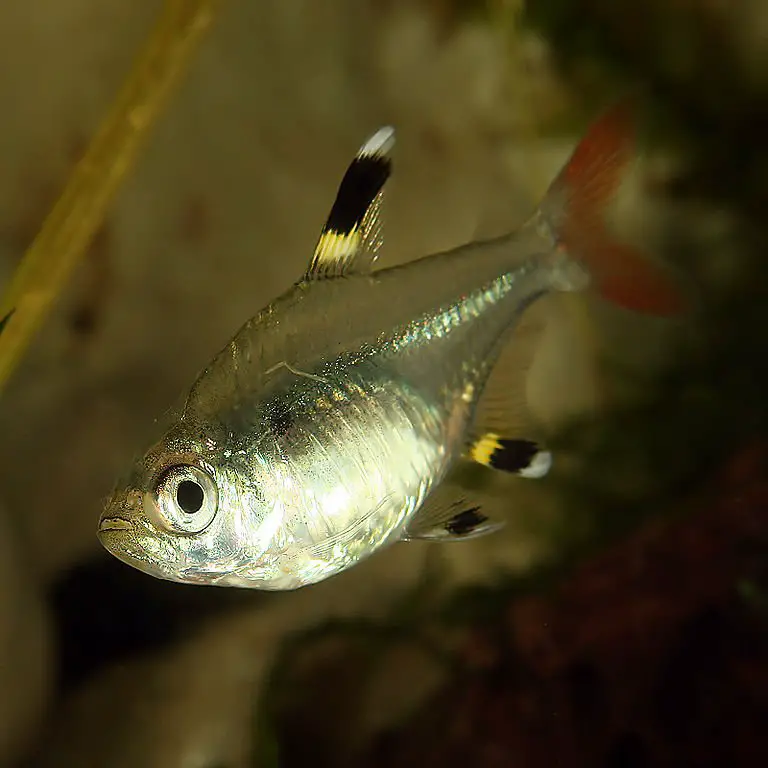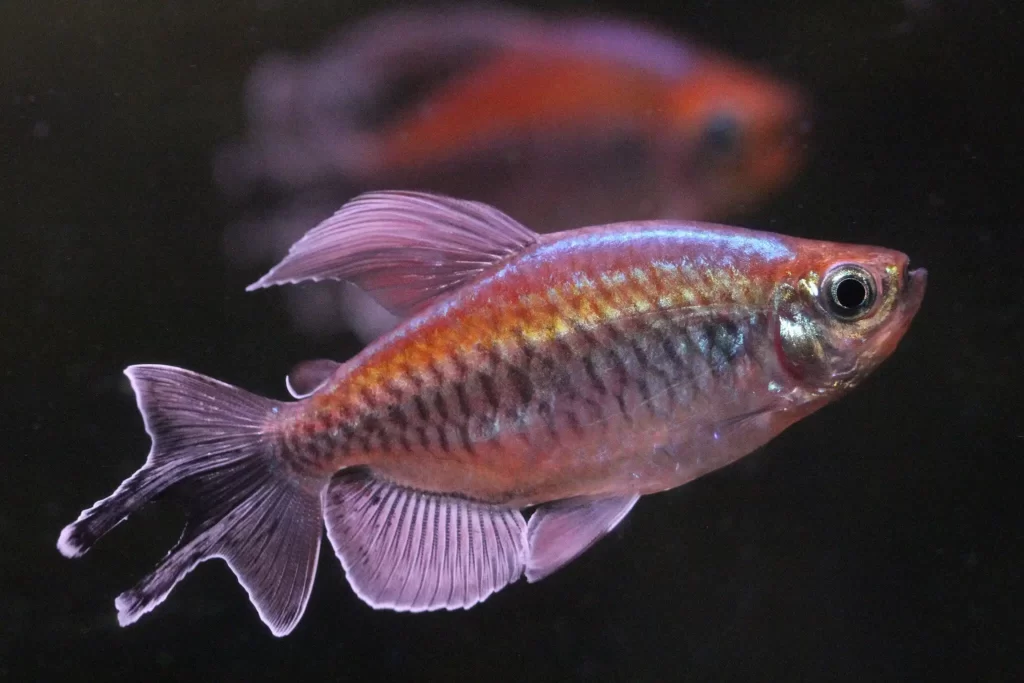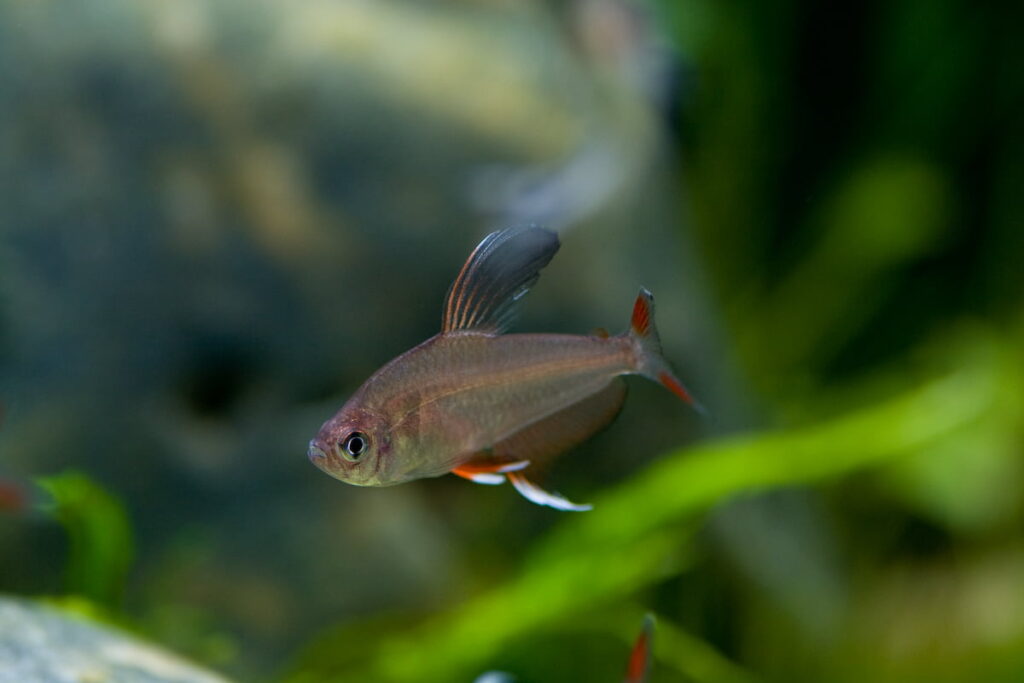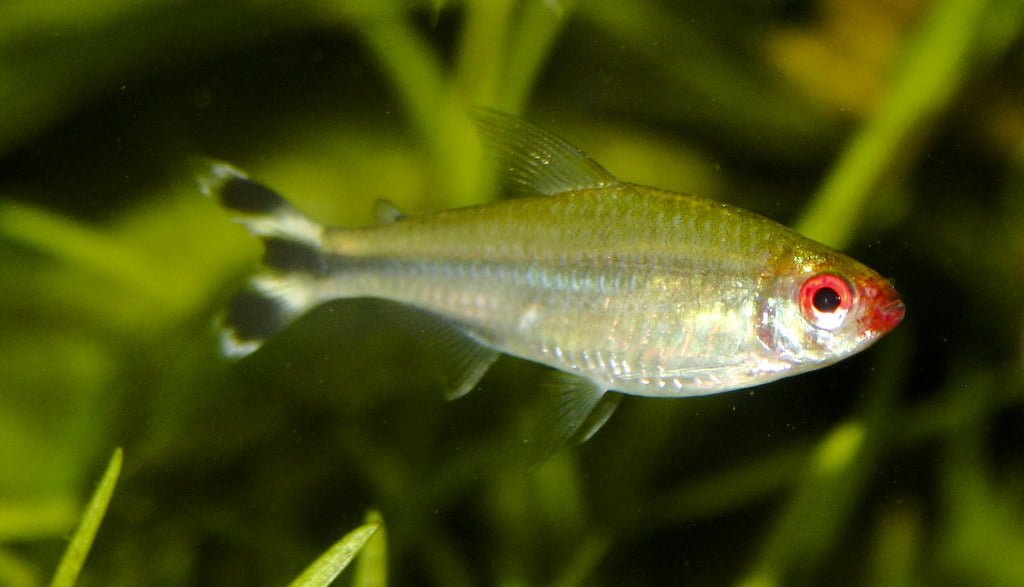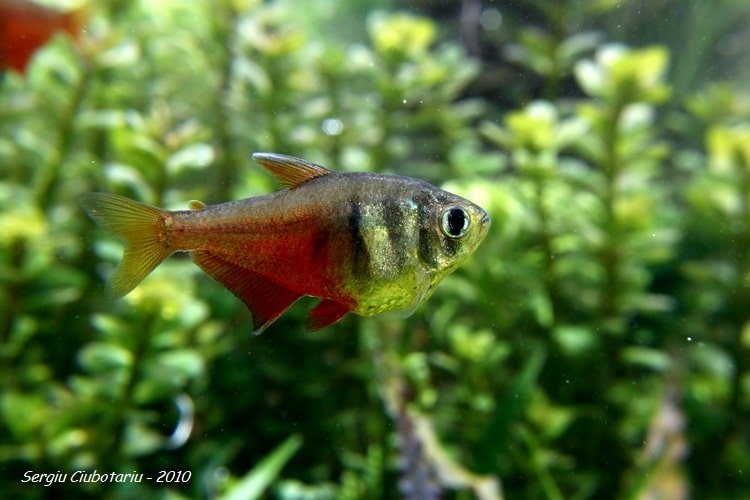X-ray tetra (Scientific name: Pristella maxillaris) is one of the most amazing fish I have come across. The fish is known as X-ray Tetra due to its distinct translucent body, making the fish’s backbone clearly visible. Found in Amazon rivers and Orinoco basins, X-ray tetras were first described by Ulrey in 1894, and have since become one of the most popular freshwater fish.
X-ray Tetra is also known as Gloden Pristella Tetra and the Water Goldfinch Tetra due to the faint golden or yellow coloration on their translucent body.
The Pristella Tetra can be really good freshwater fish for beginners. These tetras are fairly hardy fish, can adapt a wide range of water parameters than other tetras. As a beginner aquarist, you would like to add a different variety of fish in your aquarium that would be called a community tank. X-ray Tetras are peaceful in nature too you can keep them with other non-aggressive and similar kinds of fish in your community aquarium.
Imagine you are buying a tetra fish and somehow you heard about the X-ray tetra. You might get excited due to its distinct name and transparent body as you can’t wait to keep them at home aquarium. But there are lots of other things you should know before buying the x-ray tetra.
You can find all the necessary information about x-ray tetra in this article. So let’s start with the Origin of X-ray tetra.
Origin and Habitat in the wild
The X-ray tetra(Pristella maxillaris) also known as Golden tetra was described by Ulrey in 1894. They are found in South America of Venezuela, lower Brazilian Amazon, Britsh Guyana, Orinoco and coastal river drainage. X-ray tetra is popular due to its yellowish translucent body and is called by different names such as Water Goldfinch, Gloden Pristella Tetra, Pristella Tetra, pink tailed tetra.
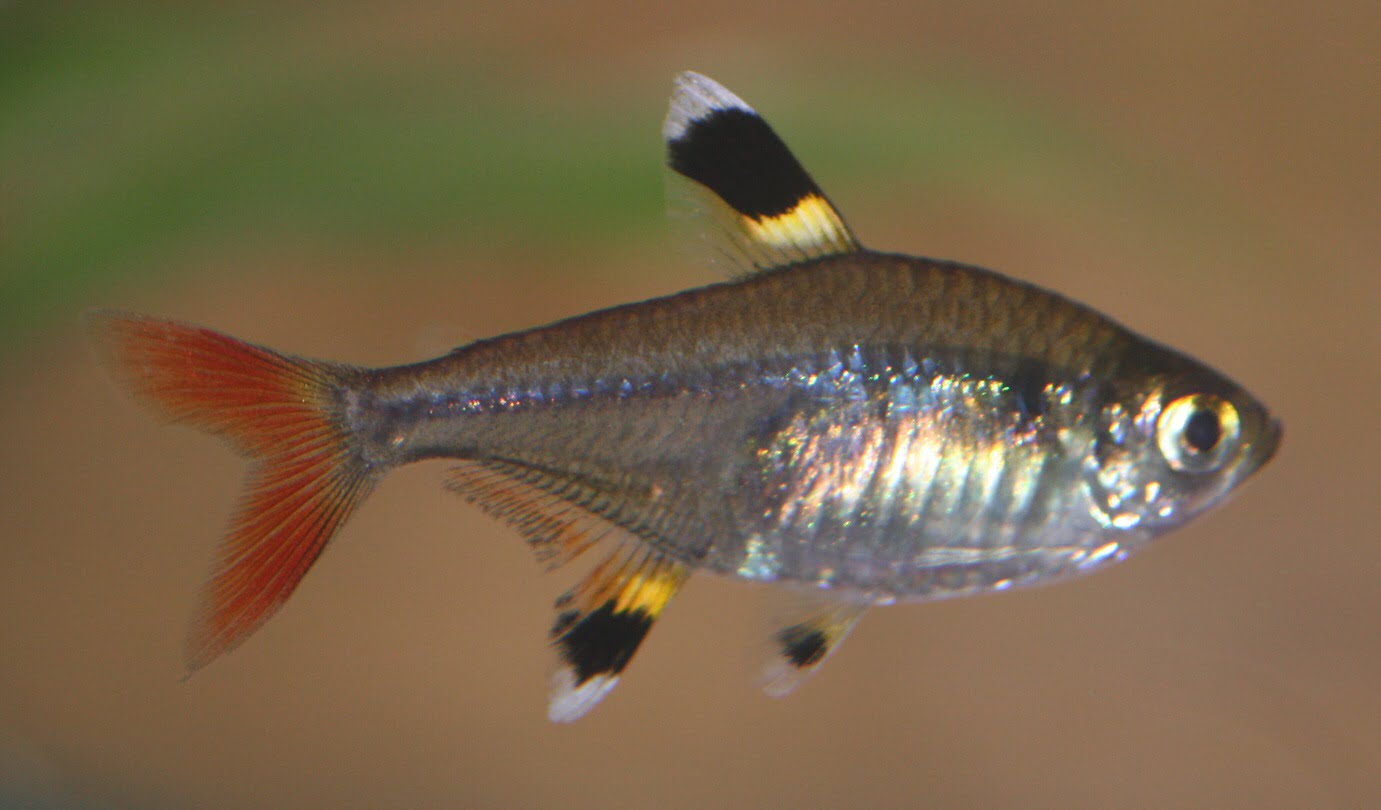
This popular fish is the only species in the Pristella genus and is not listed on the IUCN Red list as well because almost all the fish sold in the market are commercially bred in captivity.
As x-ray tetra is recognized as a peaceful tetra with its small body, they share the habitat with other species of fishes as they feel safe in groups.
X-ray tetra is a member of the Characidae Family that has a transparent body that gives the appearance of a living x-ray photograph.
In the wild, X-ray tetras are found in coastal water that is often brackish and in freshwater streams and tributaries.
During the dry season, x-ray tetra inhabits in a clear-water stream. As soon as the rainy season comes and fills up the vegetation, X-ray tetra migrates into the flooded area of savannah to spawn. They swim across the densely vegetated swamps in schools and feeds on insects, worms, and small crustaceans.
Natural habitat is best for breeding so when the environment is wet, it is more likely to be the breeding season for x-ray tetra. They will get better water conditions and good food in the form of live insects which is more nutritious that helps to grow fry faster once they hatch.
X-ray Tetra Distribution
X-ray tetra is best for the beginners, they will look stunning in the home aquarium. It is widely distributed worldwide due to its amazing transparent body. These days most of the x-ray tetra found in the stores are captive breed rather than wild-caught. Xray tetras are commercially farmed in Eastern Europe and in the Far East.
X-ray tetra makes a remarkable sale in the market due to its characteristics. and it is hard to maintain its availability ratio too as it gets sold out pretty quickly.
Characteristics
X-ray tetra has a translucent skin that covers its small body which is a pretty distinct feature than other species. They are a non-aggressive fish that loves to be in groups of other small species of tetras that help them to feel secure.
The most amazing characteristic of x-ray tetra is that their body works by transmitting sound waves through their vertebrate which is taken to the inner ear that means x-ray tetra have a good hearing capacity.
X-ray tetra can reach about 1 ¾ inch (4.5cm) in length which looks amazing in the aquarium in a group of them. A lifespan of an x-ray tetra is 4 to 5 years or even longer if you properly take care of them.
Colors and Markings
When people see the X-ray tetra for the first time, they will find a little bit strange as their body looks exactly like an x-ray where you can see the inside bone clearly. X-ray tetra body somehow seems as it faded away with the changing time but still glance wonderful.
The scales of X-ray tetra are a silvery-yellowish color that looks like a moving white ghost. When you turn on the light you almost can see them golden in color with re-tipped tail and strikingly striped dorsal and anal fins.
Besides that, you can find the silver and golden fix color form the head to middle belly of X-ray tetra with a half black and half golden dorsal tail. The anal tail pretty much looks similar to dorsal tail but the tail fin got a little bit of red color in the tip. This unique marking grabs attraction to people when it moves around the aquarium.
The whole body color and marking help the X-ray tetra safe from the predator as they will be a little bit difficult to see when close to dry wood and leaf.
Tankmates
The most amazing thing for people to see is when they buy x-ray tetra which shines the whole aquarium with its spectacular body.
Some beginners may get confused with this tetra as they have a transparent body and sometimes difficult to see in the aquarium. Due to this reason, they put x-ray tetra along with other species of fish which are bigger and faster than x-ray tetra and get in trouble.
Although x-ray has a transparent body that helps them to hide from the predators, it does not mean that they are invisible to other boisterous or much bigger species of fish.
X-ray tetra always loves to be in a group of at least 6 other fishes of its own kind that will help them to feel safe and secure. Besides that, keep them with other South American species such as small tetras, hatchet fish, pencil fish, and dwarf cichlids more likely to be Apistogramma, Corydoras and small Loricariids.
X-ray tetra is a shoaling species by nature that will be much better if kept in a group of its own kind which will be far effective for you as well as for tetra.
It is not necessary to keep them with the fish that I recommended but keep in mind not to put them with bigger fish which will solve your problem regarding the tank mates and you will not be in trouble.
X-ray Tetra Diet and Feeding
Maintaining a proper diet for a fish is essential for their growth whether its big fish or a small one. Proper feeding is as important as tank buddies for the pet fish.
Nobody knows what could go wrong if you do not feed the fish in their required time.
Generally X-ray tetra is omnivorous, they will eat all kinds of food including both live and packed food. In their natural habitat, they eat small insects, worms as well as a larva that lives close to the river bed.
But when it comes to the artificial communities, you can easily feed them supplementary food. In order to promote good coloration giving live and fresh food such as blood worms, shrimps will be the plus point that will balance their diet.
Besides that, you should maintain the feeding frequency for X-ray tetra. Sometimes way too much diet can lead to death or cause some vital diseases. You can feed them several times a day as they are in a group.
Always remember to siphon out uneaten foods as food decomposes inside the water making the water condition toxic for your fish.
Note: Only offer what they can consume in 3 minutes or less at each feeding.
Aquarium Care for X-ray Tetra
The Pristella tetra is an excellent fish for a beginner aquarist and person that has limited time to care for the fish. The fish is extremely hardy found in brackish as well as soft water. it requires little to moderate care to survive as it can withstand very hard water. You just need to do a little water change once in a while to soften the water and adjust the water parameter as it will do best in soft water.
Being said that Xray tetras are hardy fish, they still require some level of care. Any fish needs proper care so that they can live happily in your aquarium.
Nobody likes to see an aquarium filled with green water on one side of the corner at home. It looks unattractive and is harmful to your fish too.

Tank Size for X-ray Tetra
Imagine living in a small with an attached kitchen can be troublesome for us. We need comfort to survive on a daily basis. Just like that, fish also cannot survive in small tanks for a longer period of time.
X-ray tetra is fairly hardy and will do best in about a minimum of 15 to 20-gallon tank size which should have plenty of open area for swimming as they will feel comfortable and can move freely around the tank.
Always remember One inch of fish requires at least 1 gallon of water.
You can put 6 of them in the same tank with other species of fish as X-ray tetra are adaptable.
Note: If you really want to see X-ray tetra feeling more enjoyable, then the biotope tank setup will be the best.
Water Parameter for X-ray Tetra
Some people do not change the water of the aquarium for months which is just like living in a room for a month without cleaning. You should clean your aquarium from time to time that will benefit both for you as well as for fish.
X-rays can live in a variety of water conditions including soft and hard water which are rich in minerals and has an alkaline ph of 6.0 to 7.5. Still, X-ray tetra can tolerate 10% of normal salty water with a specific gravity of less than 1.0002. However, if gravity will be below 1.003, there a higher chance of death.
With the suitable water parameter, water temperature should be between 74.0 to 82.0 F that helps to feel them just like its natural environment.
There is no specific place for x-ray tetra as they will swim in all areas of the aquarium but do not forget to maintain moderate water movement including the water filter which helps them to swim easily.
See, here is a thing, unline the natural habitat of X-ray tetra or any fish, your aquarium is a closed system, right? In the wild, moving water always maintains the water parameter. However, when it comes to your aquarium, how is your tank water maintain its water parameter? The tank water won’t be healthy or clean unless you clean it yourself. Always maintain your water parameter, clean your filters once in a month, change at least 10% water in a week so that you are giving your fish a suitable and healthy environment to live.
Use test kits like API master test kit to ensure that your tank has optimum water quality. i.e. balanced ammonia, phosphate, nitrate and nitrite level.
Get yourself a good quality filter. I would recommend a canister filter of a sump filter as it will increase the volume of your aquarium water and is outside your aquarium. these are the best water filtration methods you can ever use in your aquarium.
Always use an aquarium heater to maintain your water temperature inside your aquarium. Get yourself high-quality automatic water heaters. All you will need to do is dip the heater inside your aquarium and plug it into your wall socket. It will do the rest of the job to maintain your aquarium’s water temperature.
Lightning for Aquarium
Some of the tetras love to be dark and some of them love to be in more light. According to the species, you should maintain the lighting of the aquarium.
Moderate to dim lighting will be better for X-ray tetra as they can live in any condition.
Most people do not know about these things and sometimes they even do not light the aquarium for a day which is really inhabitable for X-ray tetra.
Decoration for Aquarium
All people live in a house full of essential material that helps them in regular work basis. Lost one of the materials, then they will get unsatisfactory during work.
If people need all of those things in life, then why not be fish?
X-ray tetra will feel just like in the natural habitat if you add a few driftwoods and twisted roots in the aquarium. You can add any kind of desired shape driftwood. Sometimes x-ray tetra need to hide from other fish when they feel unsafe. So, a few handfuls of dried leaves would be acceptable for them.
You can add aquatic plants as your choice (not compulsory) inside the aquarium. If possible, use a substrate of river sand which looks like they are in the actual river bed.
Sexual Difference
You can differentiate the X-ray tetra with two things:
- Male is more slender with a sharply-pointed bladder and female is more likely to be rounded.
- Mature females are usually bigger than males.
Breeding / Reproduction
This breeding process can be a tricky part and some people do not like to breed at all. They only want to keep fish as a pet to watch and play.
For those people who want to breed the X-ray tetra and still do not know how to breed or anything about it. Here is a guide for you. here are the things you should know before breeding x-ray tetra fish.
Aquarium Setup
It is essential to set up the aquarium properly for successful breeding. You will need a dedicated separate tank if you want to breed in number. The size of the tank should be nearly 18”x10”x10” that will help them to breed more easily. Narrow tanks size will be unpleasant for X-ray tetra.
The hardest part of breeding is to find the pair as X-ray tetra seems to be picky about the partners. Since sometimes males do not responsive to female tetra. This can lead to unsuccessful breeding or can take a longer time than you imagine.
It is better to put 6 groups of tetra together for the best results as X-ray tetra spawned in pairs. The process is simple; add male and female groups in a separate tank. When females have eggs inside them, males display their best color which is pretty much fun to watch them in the aquarium. After that, if you see the fattest x-ray tetra, put them together with the best-colored male to transfer them in a spawning tank later in the evening.
Maintaining Water Parameter for Breeding
During the breeding process, X-ray tetra needs to feel just like in natural habitat. So, the temperature of the water should be well maintained of should between a range of pH5.5-6.5, GH 1-5 with around 80-85 Degree Fahrenheit. The water parameter should be soft and acidic which is best for the eggs. Use of small air-powered sponge filter will be greater.
Setup the Decoration
Female x-ray tetra tends to lay eggs on the plants such as Myriophyllum, java moss just like in the wild. Adding a more dry leaf, wood, algae would be better during the breeding process.
You might be wondering should I use the light or not.
Use of dim light while breeding is the best for X-ray tetra.
Food While Breeding
Some people usually tend to keep them alone while breeding and even don’t care about the food.
It is important to feed them proper nutritious food including a live worm for several days. Feeding them twice a day which will be beneficial for the upcoming fry as well for tetra.
Care for the X-ray Tetra Fry
After days of waiting finally, the time comes when the eggs will hatch and fry will come out. It is better to keep the eggs in a separate tank. If not possible then remove the male tetra from the aquarium as male tetra can eat the eggs.
Once a successful spawn, it will take approximately 24 to 36 hours for hatching.
Besides that, the fry are able to swim freely in 3 to 4 days of hatching. They look so tiny in a transparent body that you can barely see them. Taking care of fry is simple, just feed them infusoria-type foods until they get larger enough to eat live food or flakes.
Also remember, do not feed the fry as they hatch, the fry do carry egg yolks in their belly. This will help them get nutrition for next couple of days. Only feed the fry when they swim freely.
Conclusion
X-ray tetra is distinct in looks along with the behavior that suits them perfectly in the home aquarium. They are adaptable so it will not be difficult for you to take care of them at home.
Most of the people will find them attractive due to its transparent body.
Whether you are buying x-ray tetra for kids or for friends, you will note regrate buying the fish. And, they look always stunning in the home aquarium.
If you are a fish enthusiast and want to keep other various species of tetra, then feel free to visit Tetra fish care
